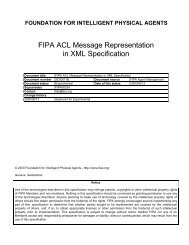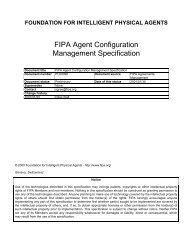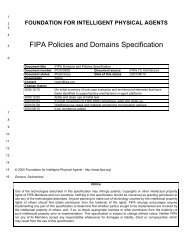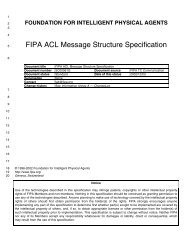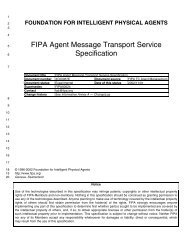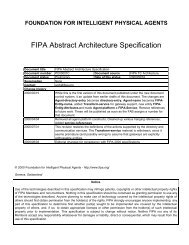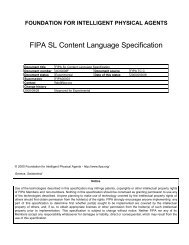FIPA ACL Message Representation in Bit-efficient Encoding ...
FIPA ACL Message Representation in Bit-efficient Encoding ...
FIPA ACL Message Representation in Bit-efficient Encoding ...
Create successful ePaper yourself
Turn your PDF publications into a flip-book with our unique Google optimized e-Paper software.
© 2000 Foundation for Intelligent Physical Agents <strong>FIPA</strong> <strong>ACL</strong> <strong>Message</strong> <strong>Representation</strong> <strong>in</strong> <strong>Bit</strong>-Efficient Encod<strong>in</strong>g<br />
286<br />
287<br />
288<br />
289<br />
290<br />
291<br />
292<br />
293<br />
294<br />
295<br />
296<br />
297<br />
298<br />
299<br />
300<br />
301<br />
302<br />
303<br />
304<br />
305<br />
306<br />
307<br />
308<br />
309<br />
310<br />
311<br />
312<br />
313<br />
314<br />
315<br />
316<br />
317<br />
318<br />
319<br />
320<br />
321<br />
322<br />
323<br />
324<br />
325<br />
326<br />
2.4 Notes on the Grammar Rules<br />
1. The first byte def<strong>in</strong>es the message identifier. The identifier byte can be used to separate bit-<strong>efficient</strong> <strong>ACL</strong> messages<br />
from (for example) str<strong>in</strong>g-based messages and separate different cod<strong>in</strong>g schemes. The value 0xFA def<strong>in</strong>es a bit<strong>efficient</strong><br />
cod<strong>in</strong>g scheme without dynamic code tables and the value 0xFB def<strong>in</strong>es a bit-<strong>efficient</strong> cod<strong>in</strong>g scheme with<br />
dynamic code tables. The message identifier 0xFC is used when dynamic code tables are be<strong>in</strong>g used, but the<br />
sender does not want to update code tables (even if message conta<strong>in</strong>s str<strong>in</strong>gs that should be added to code table).<br />
2. The second byte def<strong>in</strong>es the version number. The version number byte conta<strong>in</strong>s the major version number <strong>in</strong> the<br />
upper four bits and m<strong>in</strong>or version number <strong>in</strong> the lower four bits. This specification def<strong>in</strong>es version 1.0 (coded as<br />
0x10).<br />
3. All message types def<strong>in</strong>ed <strong>in</strong> this specification have a predef<strong>in</strong>ed code. If an encoder sends an <strong>ACL</strong> message with<br />
a message type which has no predef<strong>in</strong>ed code, it must use the extension mechanism which adds a new message<br />
type <strong>in</strong>to code table (if code tables are be<strong>in</strong>g used).<br />
4. All message parameters def<strong>in</strong>ed <strong>in</strong> this specification have a predef<strong>in</strong>ed code. If a message conta<strong>in</strong>s a user def<strong>in</strong>ed<br />
message parameter, an extension mechanism is used (byte 0x00) and new entry is added to code table (if code<br />
table is used).<br />
5. Numbers are coded by reserv<strong>in</strong>g four bits for each digit <strong>in</strong> the number’s ASCII representation, that is, two ASCII<br />
numbers are coded <strong>in</strong>to one byte. Table 1 shows a 4-bit code for each number and special codes that may appear<br />
<strong>in</strong> ASCII coded numbers.<br />
If the ASCII presentation of a number conta<strong>in</strong>s odd number characters, the last four bits of the coded number are<br />
set to zero (the Padd<strong>in</strong>g token), otherwise an additional 0x00 byte is added to end of coded number. If the<br />
number to be coded is <strong>in</strong>teger, decimal number, or octal number, the identifier byte 0x12 is used. For hexadecimal<br />
numbers, the identifier byte 0x13 is used. Hexadecimal numbers are converted to <strong>in</strong>tegers before cod<strong>in</strong>g (the<br />
cod<strong>in</strong>g scheme does not allow characters from a through f to appear <strong>in</strong> number form).<br />
Numbers are never added to a dynamic code table.<br />
Token Code Token Code<br />
Padd<strong>in</strong>g 0000 7 1000<br />
0 0001 8 1001<br />
1 0010 9 1010<br />
2 0011 + 1100<br />
3 0100 E 1101<br />
4 0101 - 1110<br />
5 0110 . 1111<br />
6 0111<br />
6. Table 1: B<strong>in</strong>ary <strong>Representation</strong> of Number Tokens<br />
7. Index is a po<strong>in</strong>ter to code table entry and its size (<strong>in</strong> bits) depends on the code table size. If the code table size is<br />
256 entries, the size of the <strong>in</strong>dex is one byte; otherwise its size is two bytes (represented <strong>in</strong> network byte order).<br />
8. Byte is a one-byte code word, Short is a short <strong>in</strong>teger (two bytes, network byte order) and Long is a long <strong>in</strong>teger<br />
(four bytes, network byte order).<br />
7



